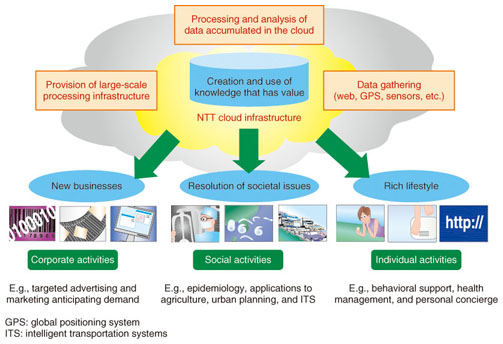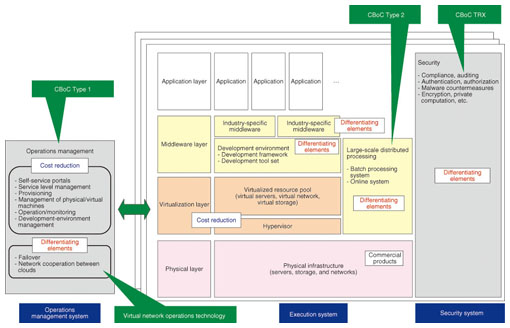 |
|||||||
|
|
|||||||
|
Feature Articles: Cloud Computing Platform Technologies for Social Infrastructure Vol. 9, No. 12, pp. 6–13, Dec. 2011. https://doi.org/10.53829/ntr201112fa1 NTT Group Initiatives for Achieving Societal Cloud InfrastructureAbstractCloud technology, which is a major trend in the field of information and communications technology, is expected to develop as a core technology for broad support of societal infrastructure in the future. In this article, we overview overall trends in cloud business and technology and then introduce the directions that the NTT Group is pursuing in cloud business, NTT R&D initiatives toward achieving them, and our main technical developments.
1. Introduction1.1 Cloud business trendsIt has already been several years since the term cloud computing came into use. Some people think that it is merely a buzzword, but all major vendors and systems integration providers in Japan are setting policies that have cloud business as a major pillar of their business strategy, and it is recognized as a paradigm shift in the field of information and communications technology (ICT). First, we provide a general overview of cloud business and its two main trends. The first trend is related to public clouds, which have been developed by major players in North America such as Google and Amazon. Both are expanding their businesses in the fields of advertising on a web search site and electronic commerce on the Internet, respectively, but in the process, they have invested in computing-resource equipment and have established scale-out* technologies for operating these large-scale systems. These scale-out technologies utilize distributed parallel processing on multiple servers and together they provide a single service (search, product recommendations, etc.). Using the facilities, operational expertise, and technical power developed in building their main business as a base, Google, Amazon, and others have developed public clouds in order to lease out facility resources on a time basis. Google Apps, the Google App Engine, Amazon Web Services, etc. are now being used, not only by consumers and startup companies, but also by ordinary companies and public services, mainly for non-mission-critical systems. The other main trend in cloud business is toward private clouds. Companies such as VMware have established virtualization technology that allows individual physical servers to be divided into multiple virtual servers. This allows computing resources to be used efficiently and enables enterprise systems to be built with flexibility and speed, at reduced cost. This has facilitated the development of a private cloud business for enterprise and promoted the migration of corporate systems, which were previously provided through on-premises (company operated) systems integration, onto private cloud systems. This movement is still mainly focused on non-mission-critical systems, but it has included some mission-critical systems and there are examples of companies building global private clouds, particularly in manufacturing and distribution industries. Commercial services for hybrid clouds, which combine private and public clouds, have also started to be offered in Japan. The technologies supporting these trends are by no means new, and the appearance of such cloud services has been made possible by increases in computer and network performance. The performance of servers and networks has improved to the level that they can be used for virtualization and distributed processing, and this has created new needs and planted the seeds for new forms of services. Both these seeds and these needs could also lead to further new trends in the future as well.
1.2 Cloud technology trendsNext, we briefly touch upon some of the latest trends in cloud technology, including the commoditization of technologies for cloud infrastructure, the commercialization of network virtualization technology and mobility of cloud resources, and large-scale data processing technology. (1) Commoditization of technologies for cloud infrastructure Conventionally, products used in the cloud industry have been centered on vendor-specific technologies, but there has recently been an accelerating trend toward open standards and commoditization. Open community initiatives are receiving particular attention with Open Compute, led by Facebook, at the facilities layer; OpenFlow from the Open Network Foundation (ONF) at the network layer; OpenStack from Rackspace, NASA, and others at the infrastructure-as-a-service (IaaS) layer; and even Cloud Foundry from VMware and others at the platform-as-a-service (PaaS) layer, as shown in Fig. 1. Commoditization at each of these layers is expected to develop further in the future. Open technologies concentrate knowledge that exceeds the frameworks of individual companies and other organizations, so it will be increasingly important to embrace these trends correctly and apply them skillfully.
(2) Commercialization of network virtualization technology and mobility of cloud resources. Virtual server and virtual storage services have already been offered using the virtualization technologies, as exemplified by services such as Amazon EC2 and S3. In addition to these, it has recently become possible to offer virtualized network equipment, such as switches and routers, and even virtualized firewalls and load balancers. Also very significant is the rapid commercialization of such network virtualization using OpenFlow, with the open technology discussed above, as the configuration-and-control protocol for virtual network equipment. A significant aspect of this network virtualization is the improvement in the mobility of cloud resources (Fig. 2). It is currently possible to migrate individual servers within the same location or to a different location in a relatively short time, either according to a plan or after a fault has occurred. However, for the entire system including the network to be usable continuously, additional operational preparations are required, such as configuration of the destination network configuration in advance. By contrast, network virtualization technology enables network setup and modification to be done rapidly and on demand, so migration becomes much easier. For storage migration, it is technically difficult to migrate large volumes of data instantly owing to network bandwidth limitations, so operational issues must also be handled by, for example, copying the data beforehand and updating it whenever there are changes.
(3) Large-scale data processing technology In the past, products such as business intelligence analysis software and data warehouse appliances were used as decision-making support tools for marketing, production, and other areas in enterprise. Recently, however, open source software (OSS) called Hadoop, which is equivalent to Google's technology used in its search processing and can process even larger-scale data, has been gaining attention and is being used more and more. Moreover, with the spread of sensor technology and embedded systems, an increasing variety of data is expected to be gathered in the future. Use of this huge volume of data in the public and consumer fields as well as enterprise is also being expected [1]. Research and development (R&D) is also progressing on realtime analysis of such sensor data. 2. NTT's cloud strategy2.1 NTT's objectives for cloud servicesIn 2008, the NTT Group established a SaaS-over-NGN task force with participation from NTT Group companies (100 members from 16 companies) to start and grow the software-as-a-service (SaaS) business and provide a SaaS infrastructure to service providers (NGN: Next Generation Network). The scope of this task force was further expanded in spring of 2010, from SaaS to the cloud, incorporating the changing conditions in technology and cloud business. The group was renamed the SaaS/Cloud task force to promote and expand the cloud business within the NTT Group overall. Within this task force, the following basic policies were decided regarding NTT's objectives in cloud services. - Provide a safe, secure, and highly reliable cloud - Provide optimized services combining applications, platforms, networks, and terminals - Make a cloud as a societal infrastructure through openness and collaboration NTT's objectives in cloud services, based on these basic policies, are shown in Figs. 3 and 4. They are supported by the following four pillars. We are advancing development of services to maximize the strengths of each NTT Group company and the strength of the whole group.
1) Provide total operation and one-stop services, including networking. 2) Provide highly reliable cloud infrastructure and cloud applications. 3) Provide seamless networking suitable for cloud applications. 4) Create valuable knowledge and solve societal issues through the accumulation and analysis of data in the cloud. 2.2 Development of cloud businessesAs shown in Fig. 5, NTT Group cloud services are being developed for enterprise, public, and consumer services, with the issues in each field being resolved.
1) Enterprise-oriented clouds: We are contributing to the expansion of cloud applications from front-end systems, which are currently the major area, to include mission-critical systems and we are expanding our customers' systems globally. We are also expanding development to include small and medium-sized businesses and industry-specific clouds. 2) Public-service-oriented clouds: We are expanding mainly in the areas of healthcare, regional government, and education, as reflected in government directions for the utilization of cloud technology. 3) Consumer-oriented clouds: We are developing these with a focus on home clouds and content distribution services, which can utilize NTT's strengths. 3. NTT R&D initiative policiesTo promote cloud activity based on its cloud strategy, NTT is advancing the following policies and developing the overall cloud business of the NTT Group and the technology needed for it. 3.1 Business developmentIn business development, NTT is working to integrate the strengths of each group company and create incremental added value by promoting cooperation among them within the three fields discussed earlier: enterprise, public, and consumer-oriented services. We are also promoting cooperation with strategic partnerships across group companies. For example, with Microsoft, we have an initiative to develop a hybrid cloud that cooperates with Windows Azure. We also plan to further expand our cloud business through collaboration with new vendors, service providers, and other business partners. 3.2 Technical developmentTechnical development on the cloud infrastructure needed to develop businesses can be divided broadly into initiatives for cost reduction and initiatives for differentiation. More specifically, the cloud infrastructure consists of execution systems, which perform the actual processing, operations/management systems, which manage the execution systems, and security systems, which handle security for the execution and operations/management systems, as shown in Fig. 6. Each of these is further divided into major functional groups, and we have initiatives in each of these areas, advancing development for cost reduction utilizing commoditized products and for differentiation from competitors.
For parts of the execution system in particular, from the facilities layer to the PaaS layer, we can use open technologies as discussed above, and there are several technologies and specifications that are expected to become commoditized in the future. We will use these proactively, and by proposing technical specifications and providing source code from NTT, we will also contribute to these open communities. We are also promoting standardization activities needed for cooperation among clouds through the Global Inter-Cloud Technology Forum (GICTF) and in other ways. On the other hand, in R&D for differentiation, we have our own development initiatives centered on virtual network operations technology, large-scale data distributed processing technology, cloud security technology, etc. and we are implementing applications of these leading-edge technologies in our cloud businesses. 3.3 Promotion of openness and collaborationWe have developed a cloud environment for R&D (R&D cloud) as a place for rapidly and smoothly promoting business- and technology-development initiatives in order to accelerate the cycle of selecting requirements and issues from the business side and providing technologies to resolve the issues from the technical development side. 4. Technical development overviewAt NTT Information Sharing Platform Laboratories, we are developing technology covering the technical development policies and trends discussed above. Below, we give an overview of the main initiatives. The name Common IT Bases over Cloud Computing (CBoC) used below is NTT's name for this development (IT: information technology). 4.1 Technical development for cost reduction in commoditized technical field(1) Cloud infrastructure operation and management technology (CBoC Type 1) Although many commercial and OSS products are already available in the field of cloud computing, technical development in the field is advancing very rapidly and many more products are expected to be available in the future. Consequently, one feature of CBoC Type 1 is that its architecture allows the execution system stack to be built flexibly using the best commercial and OSS products available at the time. We are also working to establish an operations technology for managing effective use of each type of resource (servers, storage, networks, etc.) being provided on the cloud to enable resources to be increased or decreased according to the load and to implement a mechanism for life cycle management, from construction to renewal of the cloud infrastructure. This will handle the whole cycle of provisioning, operations monitoring, and capacity planning. (2) OpenStack initiatives One of our initiatives with open technology is our proactive participation in the OpenStack community. OpenStack is an open-source cloud infrastructure technology providing functions equivalent to Amazon's EC2/S3. It has an extremely active community: the main proponents are Rackspace and NASA, but there are over 100 other companies participating, including NTT DATA, DOCOMO Innovations, and NTT from the NTT Group. OpenStack is very likely to become an industry standard in the future. In anticipation of using this software commercially, we are proposing and working on additional functions and improvements that will be required for such use and we are ensuring and improving software quality. We are also participating in the FreeCloud project, which is operating an OpenStack trial service; through this project, we are contributing to improving the operability of OpenStack. 4.2 Technical development for differentiation(1) Large-scale distributed processing infrastructure (CBoC Type 2) Large-scale data analysis technology is expected to be one of the core technologies for accumulating and analyzing data in the cloud, creating valuable knowledge, and resolving societal issues. These large-scale data analysis systems are composed mainly of 1) data gathering functions, 2) data storage and management functions (large-scale distributed processing infrastructure), and 3) data analysis functions. NTT is studying technology for designing and operating the overall architecture of these large-scale data-analysis systems. It is working particularly on a large-scale distributed processing infrastructure as a differentiating technology and also working to develop technology for reliability, operability, and performance. (2) Virtual network operations technology In cloud datacenters, with the trend toward higher concentration and multi-tenant usages through server virtualization, designing and making changes to networks within datacenters has become extremely complex. Because of this, as discussed earlier, technology that allows virtual networks to be configured on demand is attracting attention. NTT is integrating network virtualization technology into cloud systems and developing technology for operating total cloud systems. This allows network migration linked with server migration to be done automatically, and this can be applied, for example, as a disaster recover solution or as a means to reduce power consumption by optimizing server resource deployment. (3) Traceability infrastructure (CBoC TRX) With current cloud services, it is impossible to know what equipment is actually providing the service or what its operational state is, and this lack of transparency looks like a barrier to many customers from the security and operational perspectives. In response to this, we are developing technology that will provide an audit trail of what actually happened, together with visualization and certification of its safety and security, by reproducing and displaying the sequence of events in an easy-to-understand manner from various types of log data related to the human operation, content migration, and processes and the related systems distributed throughout the cloud. 4.3 NTT R&D cloud initiativesWe have consolidated the R&D cloud, which consists of well over 1000 servers, connecting R&D centers and providing a place to promote collaboration within NTT laboratories and the NTT Group. The main initiatives being undertaken with this R&D cloud are as follows. - Building a comprehensive testbed fully utilizing laboratory technologies, from datacenter facilities to application infrastructure, and establishing comprehensive technology for implementing radically increased productivity, energy conservation, and operational efficiency through cloud technology. - Providing a location for collaborative testing among group companies and creating prototypes of new services and solutions through testing of the cloud stack. - Providing a place where researchers themselves can use products developed in the laboratory on the R&D cloud, which will promote further improvements to laboratory products. This article has given an overview of technical development in NTT. The other Feature Articles in this issue give details of each technology. 5. ConclusionCloud technology is a core field of ICT and will be an important element supporting societal infrastructure in the future. The NTT Group is contributing to the creation of a cloud that will support this societal infrastructure through group-wide initiatives and the implementation of its advanced technologies. Reference
|
|||||||

















